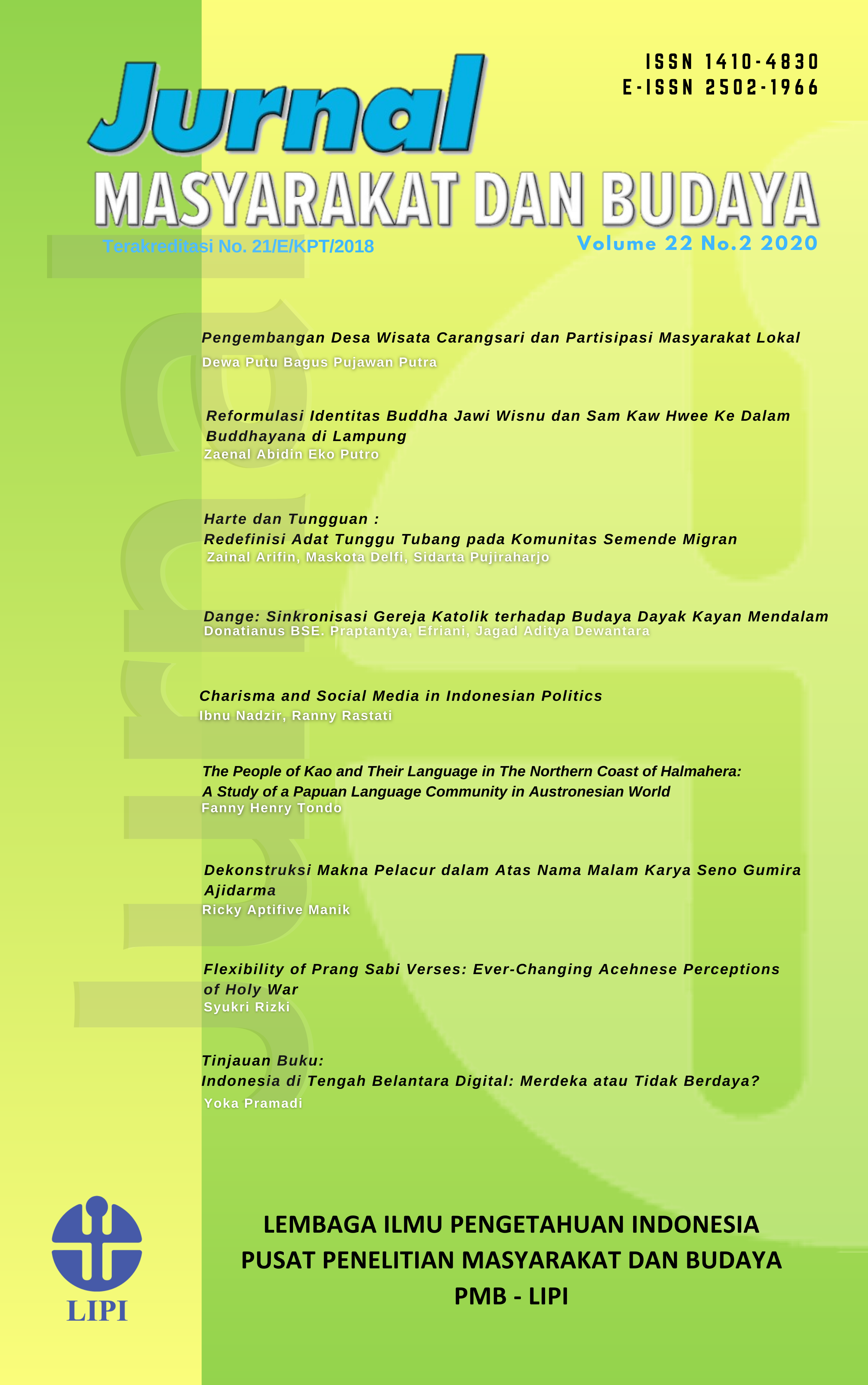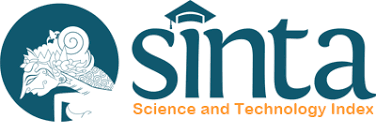FLEXIBILITY OF PRANG SABI VERSES
EVER-CHANGING ACEHNESE PERCEPTIONS OF HOLY WAR
DOI:
https://doi.org/10.14203/jmb.v22i2.1097Keywords:
prang sabi; flexible authorship; AcehAbstract
Verses of prang sabi (holy war) have been receiving various actualization throughout Aceh’s history. This paper investigates the flexible features of the authorship of prang sabi texts and their relation with the conceptualization of the idea of holy war in the Aceh society. The “flexible concept” proposed by Muhammad Haji Salleh (2018) serves as the framework on which the structure of the hikayat is unraveled. Library sources, both online and offline, provide the data for the analysis of how the idea of holy war varies in the Aceh society. Being designed with mixedmethod, the selected time frames of Aceh’s history are the times of the Dutch colonization, DI (Darul Islam) revolt, and GAM (Free Aceh Movement) insurgency. The findings reveal that the flexible concept in prang sabi texts rests on the sanjak system employed in the composition of Acehnese hikayats. This system allows improvisation for the texts to suit the contexts in which they are written. The idea of holy war to stand in the name of Islamic faith predominated during the Acehnese defense against the Dutch and of the DI’s and GAM’s revolts against the Indonesian statehood. All these movements claimed justification because the targets of the holy war were regarded as dangerous infidels (kaphé). Certain events served as the starting points of the three struggles. The Dutch annexation in 1873 marked the beginning of prang sabi against the Dutch, the abolishment of Aceh province followed by its incorporation into North Sumatera in 1951 triggered the prang sabi of DI against Indonesia, and the aspiration to separate Aceh as an independent Islamic state declared in 1976 marked the prang sabi of GAM against Indonesia. This study confirms that the flexible properties of prang sabi texts are responsible for the conceptualization of the idea of holy war in Aceh society.
Downloads
References
Abdullah, I. T. (2000). Ulama dan Hikayat Perang Sabil dalam Perang Belanda di Aceh. Jurnal Humaniora, 12(3), 239–252.
Abdullah, W., & AlFairusy, T. M. D. (1980). Katalog manuskrip perpustakaan Pesantren Tanoh Abee, Aceh Besar. Banda Aceh: Pusat Doku mentasi dan Informasi Aceh.
Akmal, S. (2015). The Language of Ex-GAM in the Media: Political rhetoric in post-conflict Aceh (Doctoral dissertation). GoetheUniversität, Frankfurt am Main.
AlMalaky, E. (2003). Why not? Remaja doyan filsa- fat: Ngomongin Islam, budaya pop, dan Gen-X. Bandung: DAR! Mizan.
Alfian, I. (1992). Sastra perang: sebuah pembicaraan mengenai Hikayat Perang Sabil. Jakarta. Jakarta: Balai Pustaka.
Arif, A. (n.d.). Seumangat Atjeh: Hikajat Prang Sabil Keunarang Tgk. di Pante Koeloe.Koetaradja: Semangat Merdeka.
Arif, A. (1946). Disekitar peristiwa pengchianat Tjoembok. Koetaradja: Semangat Merdeka.
Aspinall, E. (2009a). Islam and nation: Separatis rebellion in Aceh, Indonesia. Standford: Stand ford University Press.
Barter, S., & ZatkinOsburn, I. (2014). Shrouded: Islam, war, and holy war in Southeast Asia. Journal for the Scientific Study of Religion, 53(1), 187–201.
Dewanto, N. (2011). Daud Beureueh: Pejuang kemerdekaan yang berontak. Jakarta: Kepustakaan Populer Gramedia.
Dhuhri, S. (2016). Art as a cultural instrument: The role of Acehnese art in resolving horizontal conflict. Jurnal Ilmiah Peuradeuen, 4(1), 89–102.
Dinas Kebudayaan dan Pariwisata Aceh. (2018, February 11). GenPI Aceh: Kenalkan ragam bahasa di Aceh “OH Squad” rilis video klip keren ini. http://disbudpar.acehprov.go.id/ genpiacehkenalkanragambahasadiaceh ohsquadrilisvideoklipkerenini/
Drexler, E. F. (2009). Aceh, Indonesia: securing the insecure state. Philadelphia: University of Pennsylvania Press.
Fang, L. Y. (2013). A history of classical Malay literature. Singapore: Institute of Southeast Asian Studies.
Fathurahman, O. (2010). Katalog Naskah Dayah Tanoh Abee, Aceh Besar. Jakarta: Komunitas Bambu.
Fuadi, T. M., Musriadi, R., & Farissi, S. (2019). Dodaidi: Budaya mengayunkan anak dalam masyarakat Aceh (Perspektif filsafat pendidi kan Ki Hadjar Dewantara). Pencerahan, 13(1), 79–96.
Gibb, H. A. R. (1994). The travels of Ibn Baṭṭūṭa, A.D. 1325–1354. London: The Hakluyt Society.
Günther, S., & Lawson, T. (2017). Roads to paradise: eschatology and concepts of the Hereafter in Islam. Leiden: Brill.
Hadi, A. (1992). Aceh and the Portuguese: a study of the struggle of Islam in Southeast Asia, 1500–1579 (Doctoral dissertation). McGill University, Montreal.
Harissah. (1956). Atjeh dan peristiwa. Medan: Kaproco.
Harisson, K., Mackinlay, E., & Pettan, S. (Eds.). (2010). Applied ethnomusicology: Historical and contemporary approaches. New Castle upon Tyne: Cambridge Scholars Publishing.
Harun, R. (1982). Hikayat Prang Cut Ali. Jakarta: Departemen Pendidikan dan Kebudayaan.
Hasjmy, A. (1977). Apa sebab rakyat Aceh sanggup berperang puluhan tahun melawan Agressi Belanda. Jakarta: Bulan Bintang.
Idris, S., & Syahril. (2019). The concept of child education through Dodaidi in Aceh. Jurnal Ilmiah Peuradeuen, 7(2), 369–384.
Iskandariata, A. T. (2007). Makna Hikayat Perang Sabil di Aceh ditinjau dari filsafat analitik.. Banda Aceh: ArRaniry Press.
Kell, T. (1995). The roots of Acehnese rebellion., 1989–1992. Singapore: Equinox Publishing.
Kingsbury, D. (2006). Peace in Aceh: A personal account of the Helsinki peace process. Jakarta: Equinox Publishing.
Kloos, D. (2014). A crazy state: Violance, psychia try, and colonialism in Aceh, Indonesia, ca. 1910–1942. Bijdragen Tot de Taal-, Land-En Volkenkunde/Journal of the Humanities and Social Sciences of Southeast Asia, 170(1), 26–65.
Linge, L. A. (1993). Malapetaka di Bumi Sumatera. Medan: PT Kemalasari Enterprice.
Khaan, Moel (2013). Hikayat Prang Sabi (Versi ASNLF). https://www.facebook.com/AchehSu matraNationalLiberationFront [Facebook update] Retrieved from https://www.facebook. com/AchehSumatraNationalLiberationFront/ posts/hikayatprangsabiversiasnlfsubhanallahwahdahuwabihamdihikhalikulbadri wal/593789790663306/. Accessed on July 23, 2020.
Muhammad, M. S. (2013). Motivasi perang sabil di Nusantara: kajian kitab Ramalan Joyoboyo, Dalailul-Khairat, dan Hikayat Perang Sabil. Ciputat: Media Madania.
Orang Hutan Squad. (2018, June 26). Orang Hutan Squad - Prang Sabi (Official Music Video) [Video]. Youtube. https://www.youtube.com/ watch?v=X6KqRBuWiEM. Accessed on October 19, 2020.
Orang Hutan Squad. (2019, June 09). Orang Hutan Squad - Meuseuraya (Official Music Video) [Video]. Youtube. https://www.youtube.com/ watch?v=ChbVA2xpeuc. Accessed on October 19, 2020.
Orang Hutan Squad. (2020, March 25). Orang Hutan Squad - Keudonya (Official Music Video) [Video]. Youtube. https://www.youtube.com/ watch?v=1fUinOAhbS0. Accessed on October 19, 2020.
Piekaar, A. J. (1977). Pengetahuan dan masyarakat : orasi ilmiah, diucapkan pada rapat senat terbuka memperingati Hari Jadi Ke 16 dan Wisuda Sarjana Universitas Syiah Kuala, Sabtu, 3 September 1977 / Dr. A.J. Piekaar. Banda Aceh: Universitas Syiah Kuala.
Prang Sabi Mewarnai Milad GAM. (2016, December 5). Serambinews.com. Retrieved from https:// aceh.tribunnews.com/2016/12/05/prangsabi warnaimiladgam.
Salleh, M. H. (2018). Yang empunya cerita: the mind of the Malay author. Kuala Lumpur: Dewan Bahasa dan Pustaka.
Schulze, F. (2010). From colonial times to revolution and integration. In A. Graf, S. Susanne, & E. Wieringa (Eds.), Aceh: History, politics and culture (p. 63). Singapore: Institute of South east Asian Studies.
Siegel, J. T. (1969). The rope of God. Chicago: Uni versity of California Press.
Sjamsuddin, N. (1990). Pemberontakan Kaum Repub- lik: Kasus Darul Islam Aceh. Pustaka Utama Grafiti.
Snouck Hurgronje, C. (1906). The Achehnese (Vol. 1). Leiden: E. J. Brill.
Talsya, T. A. (1982). Cut Nyak Meutia: srikandi yang gugur di medan perang Aceh. Jakarta: Mutiara.
Taslim, N. (2010). Narrative of war: Acehnese per ception of the Prang Kaphe in 19/20th century colonial era. Institute of the Malay World and Civilisation, 26, 139–153.
Tiro, H. M. (1999). Demokrasi untuk Indonesia. Jakarta:Teplok Press.
Umar, M., & Chaidar, A. (2006). Darul Islam Aceh: Pemberontak atau Pahlawan? Banda Aceh: Pemda Nanggroe Aceh Darussalam.
Voorhoeve, P. (1994). Catalogue of Acehnese manu- scripts in the library of Leiden University and other collections outside Aceh. Leiden: Leiden University Library.
Warnk, H. (2009). Searching for seeds to rest in libraries: European collecting habits towards Malay books and manuscripts in the Nineteenth Century (No.1, October, 2009). Frankfurt am Main: Interdisciplinary Centre of East Asian (IZO).
Zainuddin, H. M. (1960). Hikajat Prang Sabi. Medan: Pustaka Iskandar Muda.
Zentgraaf, H. C. (1938). Atjeh. Batavia: Koninklijke Drukkerij De Unie.

Published
Issue
Section
Copyright (c) 2020 Syukri Rizki Rizki

This work is licensed under a Creative Commons Attribution-NonCommercial-NoDerivatives 4.0 International License.
Authors who publish with this journal agree to the following terms:
- The copyright for articles in this journal is retained by the authors.
- Authors grant to the journal first publication rights and the right to distribute the article, including the journal's web site, online data bases and other similar forms.
- Authors agree to license their work according to Creative Commons Attribution-NonCommercial-NoDerivatives 4.0 International License.
- Articles published in JMB are free to use for non-commercial uses as long as the authors and the journal are attributed properly and the new creations are licensed under the indentical terms (license Creative Commons (CC BY-NC-ND 4.0).
- Authors retain the right to reproduce and distribute their articles in any format, without prior authorization, with the proper acknowledgment to the first publication.
- If the article contains copyright material owned by others, authors should obtain written permission from the copyright owner/s in order to reuse the material. Appropriate acknowledgment should be included.
- Authors are encouraged to post their article online (in institutional repositories, personal websites etc). Any such posting must include a reference and a link to the journal's website.
Penulis yang menerbitkan pada jurnal ini menyetujui ketentuan berikut:
- Hak cipta untuk artikel dalam jurnal ini disimpan oleh penulis.
- Penulis memberikan kepada jurnal hak publikasi pertama dan hak untuk mendistribusikan artikel, termasuk situs web jurnal, basis data online dan bentuk serupa lainnya.
- Penulis setuju untuk melisensikan karya mereka sesuai dengan Creative Commons Attribution-NonCommercial-NoDerivatives 4.0 International License.
- Artikel yang diterbitkan dalam JMB bebas digunakan untuk penggunaan non-komersial selama penulis dan jurnal dikaitkan dengan benar dan kreasi baru dilisensikan menurut istilah indentis (lisensi Creative Commons (CC BY-NC-ND 4.0).
- Penulis mempertahankan hak untuk mereproduksi dan mendistribusikan artikel mereka dalam format apa pun, tanpa izin sebelumnya, dengan pengakuan yang tepat untuk publikasi pertama.
- Jika artikel tersebut berisi materi hak cipta yang dimiliki oleh orang lain, penulis harus mendapatkan izin tertulis dari pemilik hak cipta untuk menggunakan kembali materi tersebut. Pengakuan yang tepat harus disertakan.
- Penulis didorong untuk memposting artikel mereka secara online (dalam repositori institusional, situs web pribadi dll). Setiap posting seperti itu harus menyertakan referensi dan tautan ke situs web jurnal.
.png)









